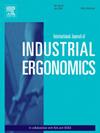Impact of floor inclination on torque production, ground reaction forces, and postural adjustments during handwheel operations
IF 2.5
2区 工程技术
Q2 ENGINEERING, INDUSTRIAL
International Journal of Industrial Ergonomics
Pub Date : 2025-04-14
DOI:10.1016/j.ergon.2025.103740
引用次数: 0
Abstract
How does floor inclination alter balance and force capacities during handwheel operations, further affecting control operations and ultimately threatening safety in domains such as naval, aviation, construction, and agriculture? This study investigates the effects of different floor inclinations on torque production, ground reaction forces, and postural adjustments during a handwheel maneuvering task. Participants performed maximal isometric torque exertion by operating a handwheel at floor inclinations ranging from 30° backward to 30° forward around the transverse axis. Handwheel torque, Ground Reaction Forces (GRFs) under both feet, and kinematics data for postural adjustments were recorded. The results revealed significant variations in handwheel torque production, GRFs distribution, and postural alignment as a function of inclination angle. Specifically, there was a significant reduction in handwheel torque production of up to 19 % (p < 0.01) at extreme forward inclination and 16 % (p < 0.05) at extreme backward inclination compared to the horizontal condition. GRFs analysis showed adjustments in forces distribution between the feet. Kinematics analyses demonstrated significant postural adjustments affecting body alignment and force generation capacity. This study provides critical data for design engineers, highlighting the challenges of handwheel torque production and the importance of considering lower limb contributions and postural adaptations at steep inclinations. These results emphasize the need to account for floor inclination in equipment design and operator training can enhance safety and performance.
求助全文
约1分钟内获得全文
求助全文
来源期刊
CiteScore
6.40
自引率
12.90%
发文量
110
审稿时长
56 days
期刊介绍:
The journal publishes original contributions that add to our understanding of the role of humans in today systems and the interactions thereof with various system components. The journal typically covers the following areas: industrial and occupational ergonomics, design of systems, tools and equipment, human performance measurement and modeling, human productivity, humans in technologically complex systems, and safety. The focus of the articles includes basic theoretical advances, applications, case studies, new methodologies and procedures; and empirical studies.

 求助内容:
求助内容: 应助结果提醒方式:
应助结果提醒方式:


